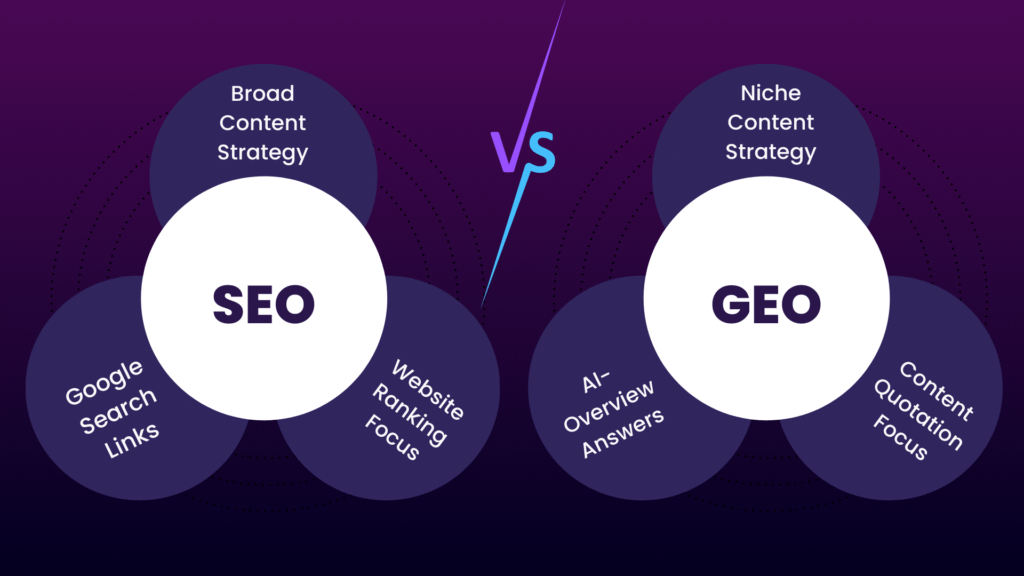In our B2B SEO Strategy Guide, we talked about how SEO in 2025 isn’t just about Google rankings anymore – it’s about visibility across discovery platforms. That shift? It’s what brought us here – to the fast-emerging world of GEO: Generative Engine Optimization, bringing forward a fresh perspective that’s Geo vs SEO – how do these strategies differ in the evolving digital landscape?
Also, If you’ve never heard of GEO before, here’s the quick version: It’s the art (and science) of showing up in responses generated by AI tools like ChatGPT, Perplexity, Bing Copilot, and others.
These platforms don’t operate on the same search mechanics as Google. They don’t return a list of links – they take in questions (most likely) and then give out the most relevant answers. And whether your business is included in those answers or not comes down to how GEO-aware (or how contextually relevant) your content is.
At Digi-tx, we’ve already seen this shift happen in real-time. Our own site started showing up as a reference on Perplexity AI, even before we began actively optimizing for it. (And yes, we flexed a little.) But it wasn’t a fluke. It happened because our content — across blogs, landing pages, and tools like our SEO stack – was structured, trustworthy, and targeted at real user intent.
Why GEO? – Buyers are increasingly searching for answers to their problems on AI applications. Having your brand reflected in these answers strengthens your credibility and increases the chances of your buyers exploring your website sooner than if you were just on Google.
This blog is where we go deeper. We’ll break down what GEO really is, how it compares to traditional SEO, and why startups (especially in competitive spaces like cybersecurity and SaaS) need to think about both – not just one.
GEO and SEO: Same Goal, Different Rules
At first glance, SEO and GEO might feel like cousins from the same digital family. Both are centered on visibility. Both rely on content. Both are critical to how your brand (and specifically website) shows up online. But when you peel back the layers, the game mechanics are very different. This brings us to the debate: SEO vs Geo – which approach aligns better with your business objectives?
Take SEO, for instance. SEO focuses on optimizing websites to rank higher in traditional search engines like Google, relying on elements such as keywords, backlinks, and site structure.
It’s about improving your visibility across a web of ranking signals—like page speed, content depth, user intent, and internal linking. Over time, SEO helps your brand claim valuable search engine real estate and attract traffic that aligns with your funnel.
But as the way people search continues to evolve, visibility isn’t limited to just traditional search engines anymore.
GEO, or Generative Engine Optimization, by contrast, aims to increase content visibility in AI-driven platforms like ChatGPT and Perplexity, which deliver direct answers rather than just link-based results.
These platforms don’t just return a list of websites—they generate synthesized responses based on the most relevant and high-quality content available. The real question becomes: Is your content strong enough to be quoted in those AI-generated answers?
That’s where the synergy between SEO and GEO becomes important. GEO isn’t replacing SEO—it’s complementing it. As generative search engines grow in popularity, integrating GEO ensures your content remains discoverable across both traditional and AI-powered search formats. Understanding the nuances of Geo vs. SEO can help in crafting a balanced strategy that leverages the strengths of both.
Think of it this way:
- SEO gets you ranked.
- GEO gets you quoted.
The difference between the two is subtle but powerful – and failing to adapt to this shift means your content might never see the light of day on the discovery platforms of 2025 and beyond.
How Generative Engines Decide What to Show?
Unlike traditional search, generative engines don’t rely solely on web crawlers and link-based authority.
They synthesize responses based on natural language understanding, relevance, contextual depth, and knowledge graphs. So, if your content is thin, generic, or made “SEO-friendly” just for Google bots – chances are, it won’t get surfaced by Perplexity or ChatGPT.
These engines look for:
- Topical specificity: Broad blogs don’t make the cut. Niche content wins.
- Clear structuring: Headers, bullet points, and sectioned answers are easier to parse.
- Recency & credibility: Outdated content gets skipped. Authoritative tone and citations matter.
- Unique insight: You can’t just re-hash the currently available results on Google and hope to get quoted by AI. Your content needs to be unique.
We saw this first-hand at Digi-tx. Our site began appearing on Perplexity AI when we leaned into long-form, problem-solving content in cybersecurity and B2B marketing. No paid campaigns. No plugins. Just good structure, strong relevance, and a lot of clarity.
That’s the power of GEO-aware content. And if you’re a niche B2B brand, this is where you can outshine even the biggest players.

What Kind of Content Works for GEO?
Here’s where things get tactical. GEO content isn’t about volume – it’s about information density and intent alignment.
Founder-Led POVs & Deep Blogs
Generative engines value original voices and deep expertise. That’s why first-person content – like founder breakdowns or CMO-authored posts – performs exceptionally well. Not because it’s flashy, but because it feels real. It demonstrates skin in the game, which AI models interpret as trust signals.
Structured Lists That Deliver Context
Lists aren’t just listicles anymore. When well-formatted and detailed, they make it easy for Perplexity or Bing Copilot to pull ranked comparisons or step-by-step instructions. Instead of just “5 Email Security Tools”, try “Top 5 Email Security Tools for Healthcare Startups in 2025 (With Compliance Notes)”.
Content with FAQs & Schema
We discussed this in our Top B2B SEO Tools post — using tools like Merkle Schema Generator to wrap your FAQs and definitions in structured data. This makes your content more “machine-readable” – and vastly increases the chances it’ll show up in AI-powered answers.
Case Studies & Specific Examples
AI engines love evidence-based writing. Detailed case studies (like “How we helped a healthcare startup strengthen their security posture “) show up because they explain what happened – not just what’s possible.
All of this aligns closely with what we build in our startup SEO agency model: educational, intent-matching, technically sound content that can be repurposed for GEO without rewriting your whole site.
Generative Engine Optimization – An extension to SEO
The question isn’t “GEO vs SEO”. It’s about how to stack both for your brand without burning resources?
Here’s how we build the content system at Digi-tx:
- Start with an intent-driven SEO roadmap using tools like Semrush and SparkToro
- Structure content clusters with pillar + sub-topic blogs to build topical authority
- Embed schema, alt-tags, and rich metadata from day one
- Prioritize long-form, niche-specific blogs with real examples (not keyword fluff)
- Update high-performing SEO content for GEO discoverability – think better formatting, new FAQs, human quotes, clearer subheadings
This layered approach makes your brand visible in two very different universes: traditional search, and the emerging generative layer. It future proofs your content. And in 2025, that’s non-negotiable.
Why Startups Need to Be First Movers on GEO?
Enterprise brands still move like battleships. That’s your unfair advantage.
GEO is a massive opportunity for startups – especially in high-value sectors like cybersecurity, AI, health-tech, and vertical SaaS. Here’s why:
- You’re closer to the problem – which means your content can be more relevant and specific.
- You’re more agile – which means you can adapt to new formats, trends, and tools.
- You’re less noisy – which means generative engines can actually notice you.
If you’re already publishing long-form content, running SEO campaigns, and creating LinkedIn or YouTube content – like we discussed in the B2B SEO Strategy Guide — you’re almost there, probably 80%. The rest is intentional structure and a few strategic tweaks.
We’ve seen this play out for clients already.
And Digi-tx being cited on Perplexity AI without a dollar spent on paid promotion? That’s partially luck. But mostly, it’s the way we designed & strategized our content that helped us get there.
GEO Isn’t a Fad – It’s the New Baseline
In a world where search is transforming into answers, and AI platforms are mediating for people to find products, services, and partners – you need to rethink your visibility strategy.
Start by building strong SEO foundations. Then layer in smart GEO principles:
- Be useful.
- Be structured.
- Be specific.
- Be human.
If you’re wondering whether your content is ready for this next evolution of search, or how to repurpose what you already have – we’re happy to help.
Let’s make sure your business shows up – not just on Google, but also on AI platforms where your audience is asking more specific questions.





